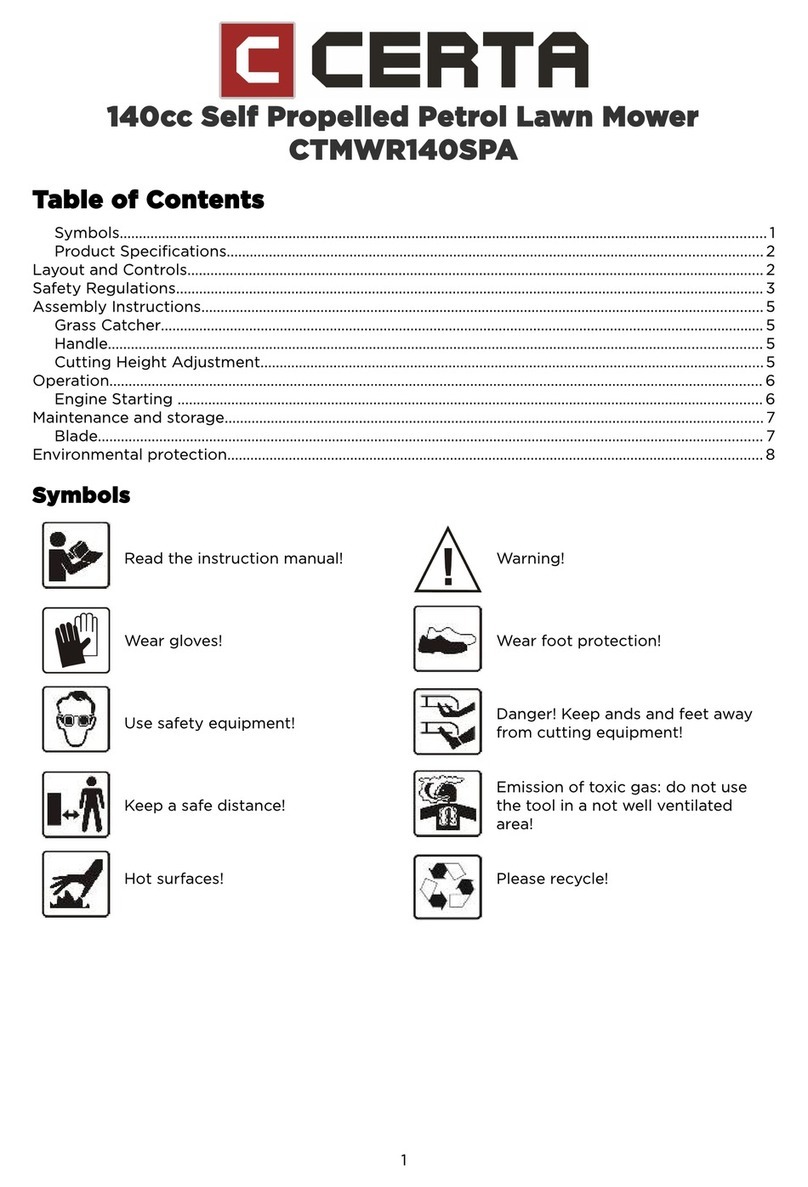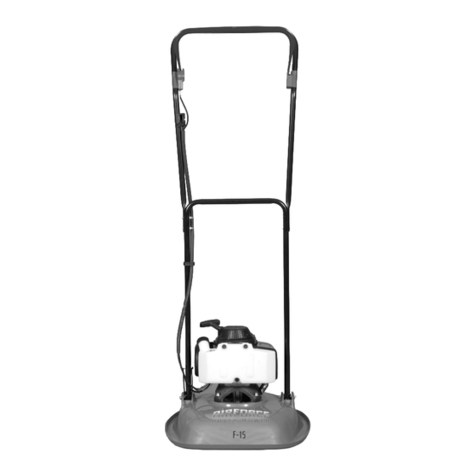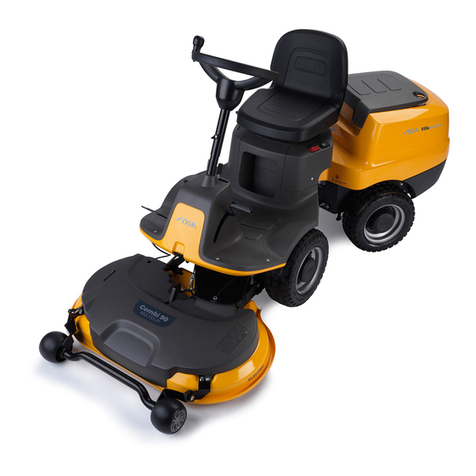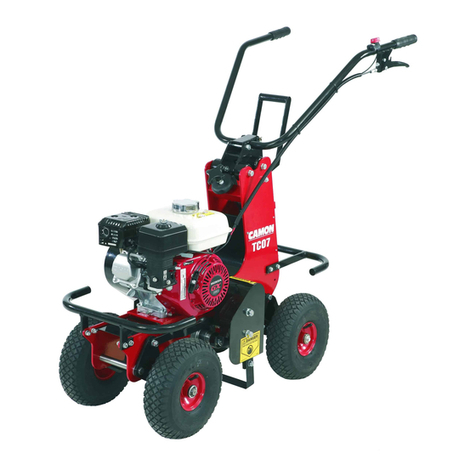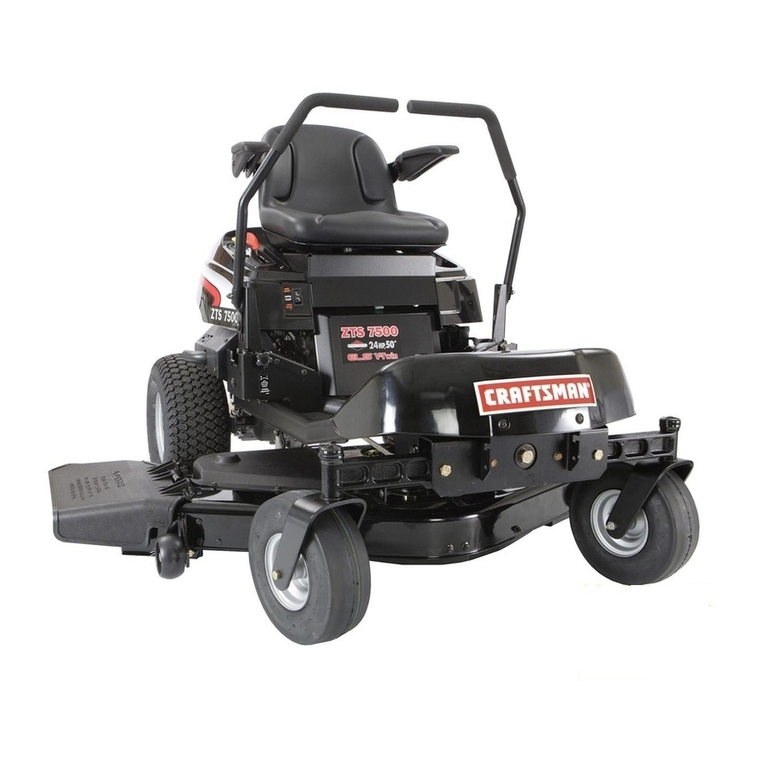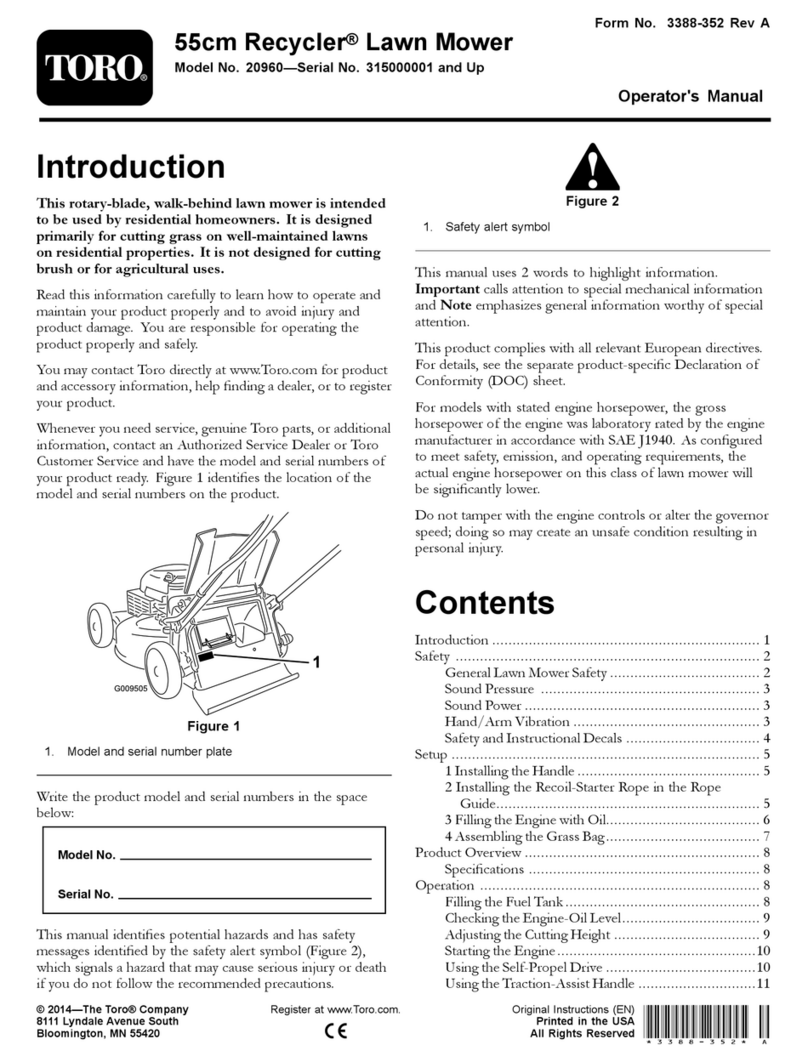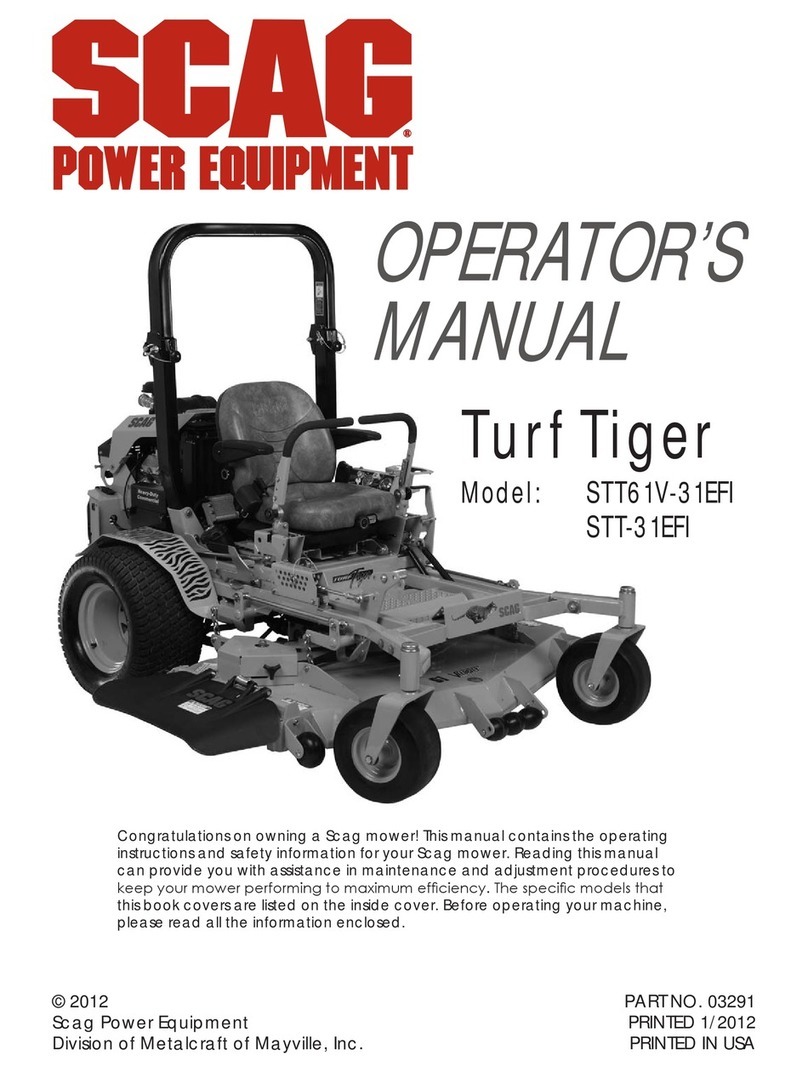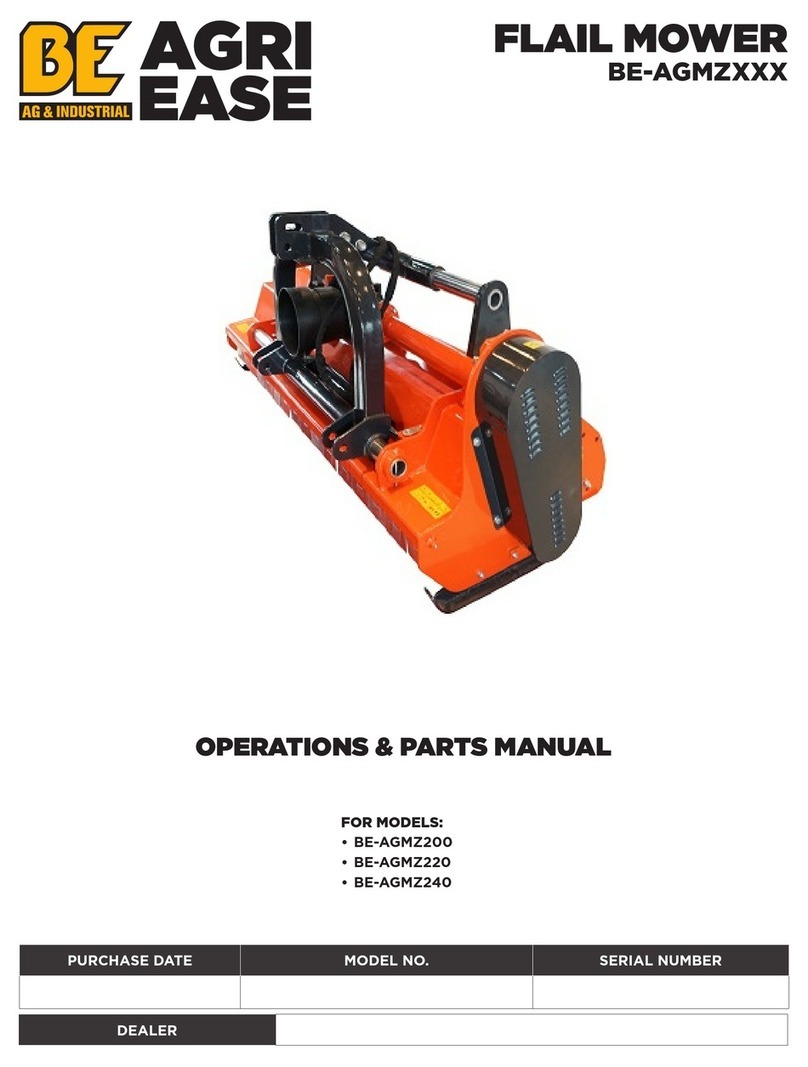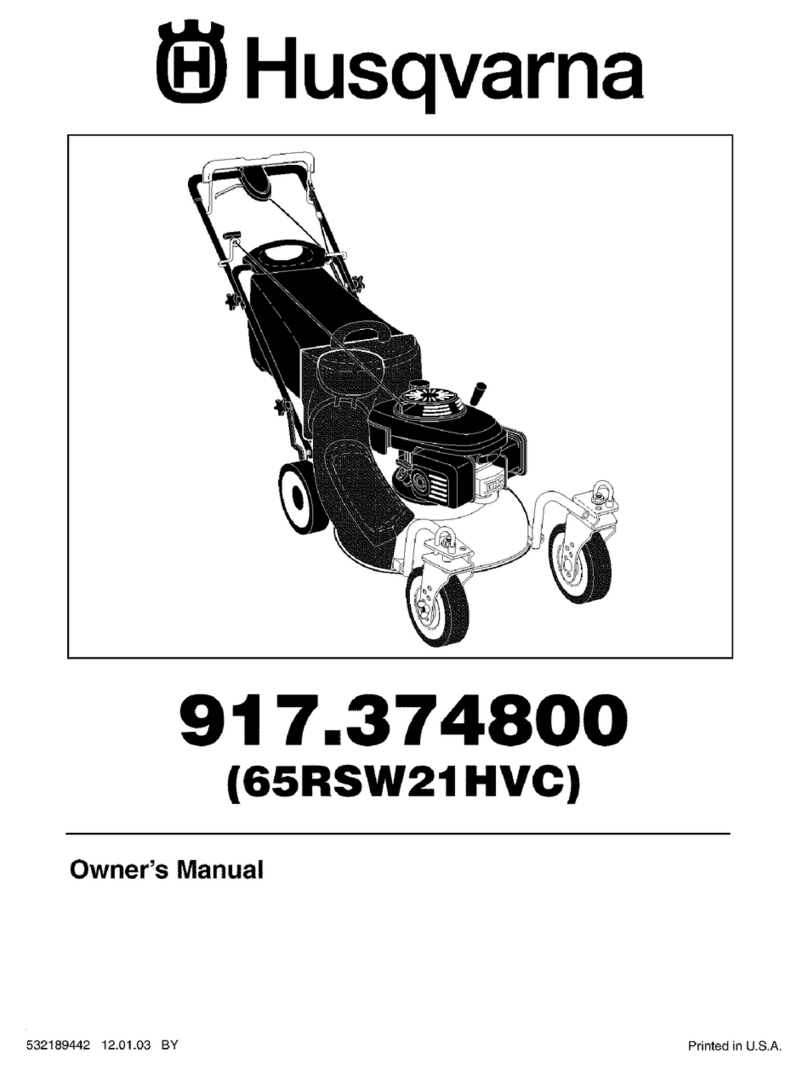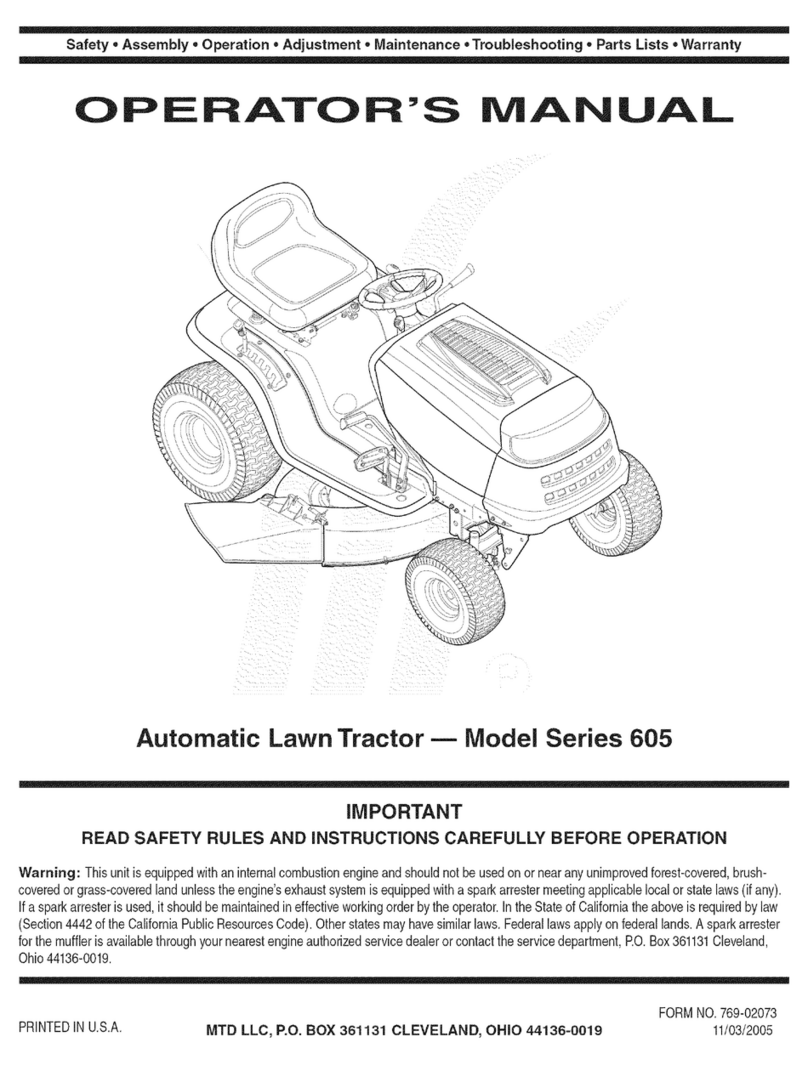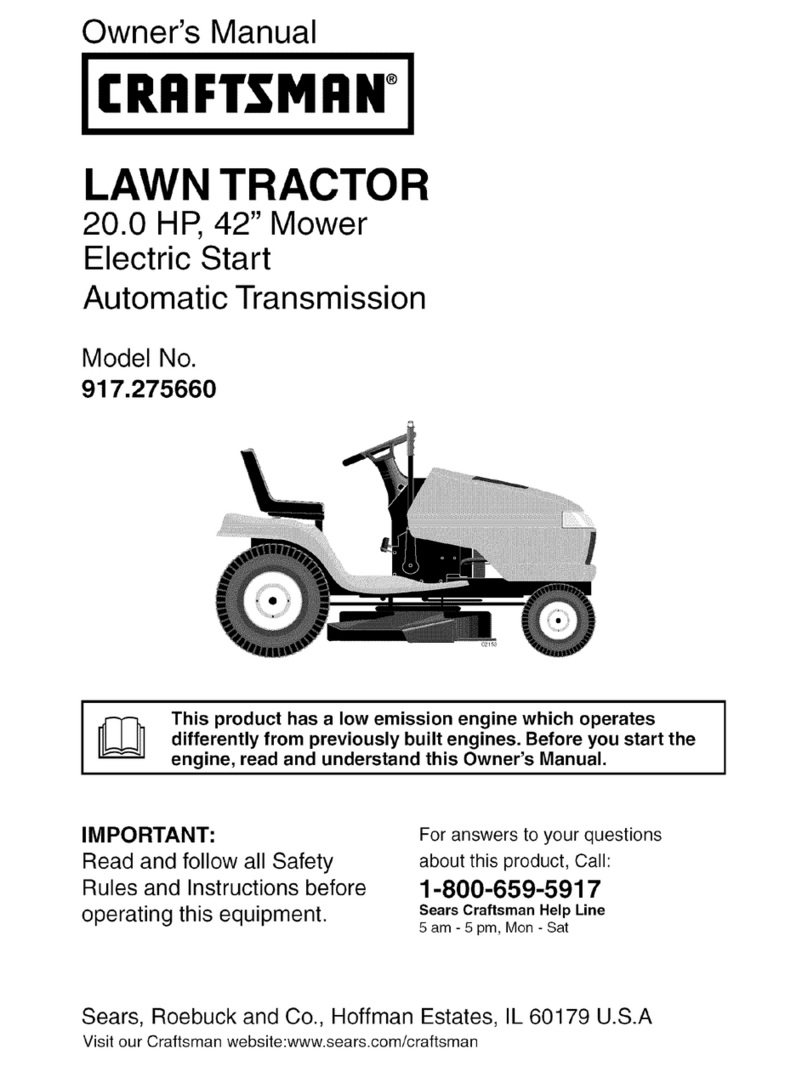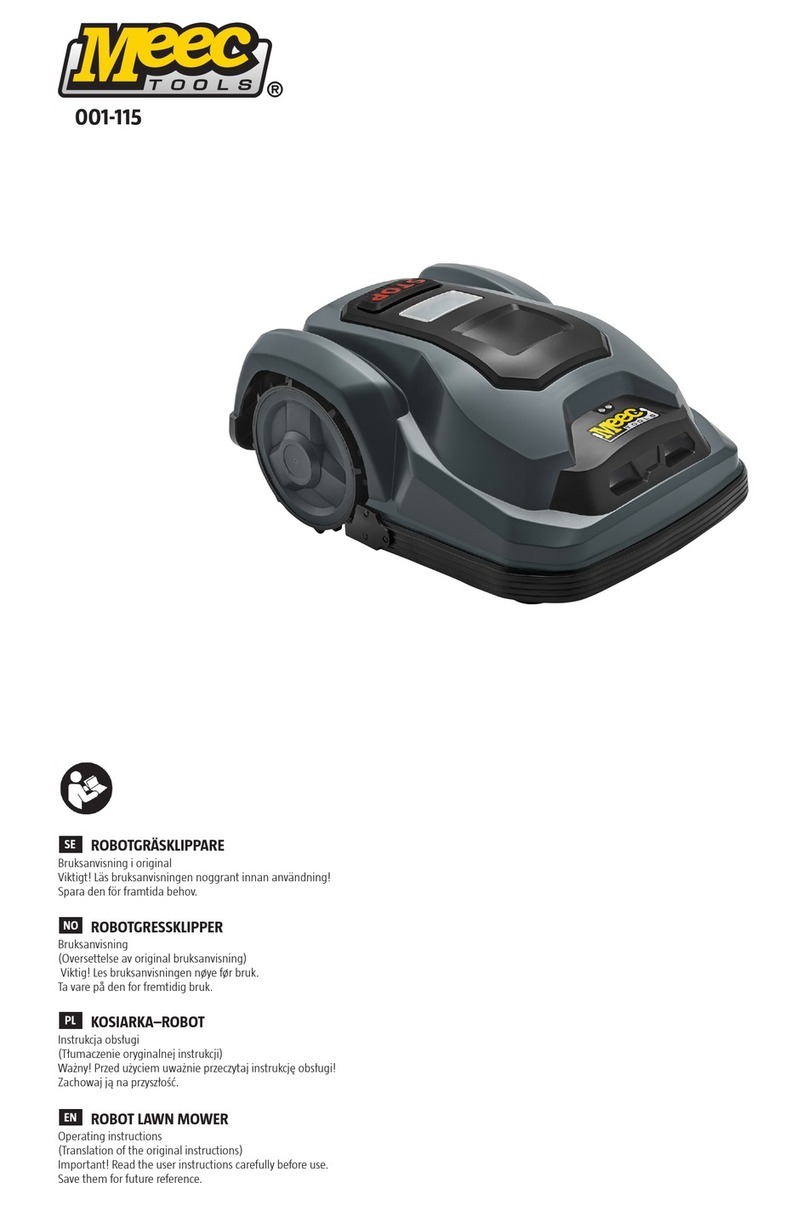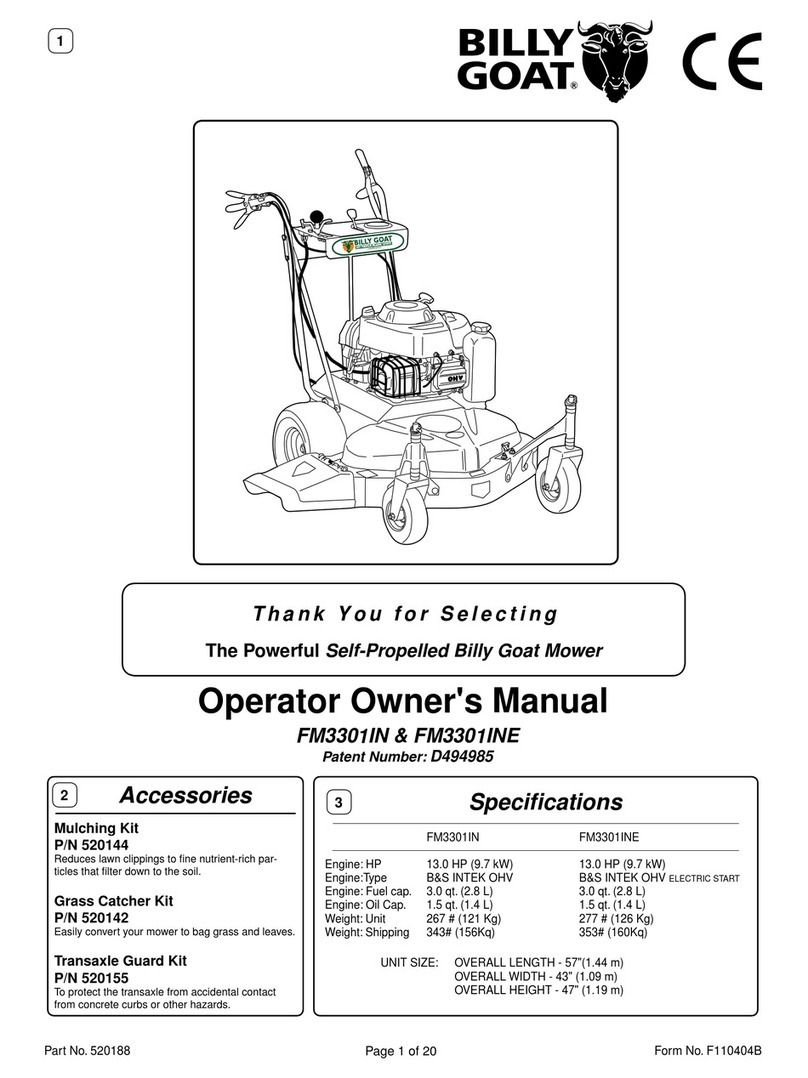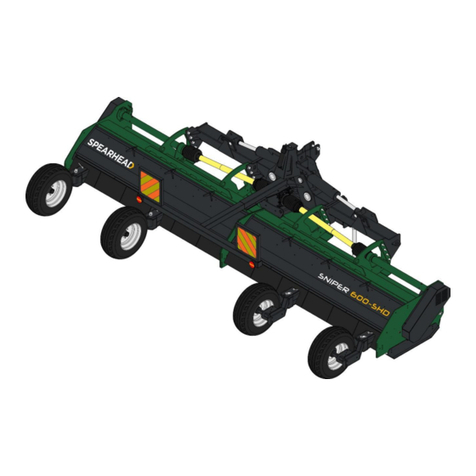Certa CTMWR40V37A User manual

40V BATTERY POWERED 37CM
HAND PROPELLED LAWN MOWER
CTMWR40V37A


Save all warnings and instructions for future reference.
Symbols on the lawn mower
General safety warning!
Before switching on the lawn mower, read the operating manual!
Remove the safety key before carrying out any work on the unit and before
leaving the unit.
Keep third parties away from the danger area! Always maintain a safe
distance from the lawn mower when it is working!
Ejected objects and rotating parts can cause serious injuries.
CAUTION! Sharp cutting tool! Keep hands and feet away from the cutter
bar!
CAUTION! The device must not be operated without a protective hood (discharge flap)
and a grass catcher.
Protect the device from rain and do not leave it outdoors in the rain!
The guaranteed sound power level is 96dB.
Disposal information (See page 14)!
Direct current (DC).
SAFETY & WARNINGS
WARNING: Read all safety warnings and all instructions. Failure to
follow the warnings and instructions may result in electric shock, fire and/or
serious injury.

Symbols used in this user guide
WARNING!
Denotes impending danger. Non-observance of this warning may result in
death or extremely severe injuries.
CAUTION!
Denotes a potentially dangerous situation. Non-
observance of this warning may
result in injury or damage to property.
NOTE:
Denotes application tips and important information.
For your safety
WARNING!
Before using the lawn mower, read and follow:
•This user guide
•The user instructions of associated/ supplied accessories (charger, battery),
•The currently valid site rules and the regulations for the prevention of accidents.
User
This lawn mower is not intended for use by persons (including children) with reduced
physical, sensory or mental capabilities, or lack of experience and know-ledge, unless they
have been given supervision or instruction concerning use of the machine by a person
responsible for their safety.
Never allow children or people unfamiliar with these instructions to use the lawn mower.
Children should be supervised to ensure that they do not play with the lawn mower.
Intended use
This unit is intended exclusively for lawn mowing.
Any other use is not as intended. Improper use is not covered by the warranty and the
manufacturer will reject any liability. The user is liable for all injuries to third parties and
damage to their property.
Operate the lawn mower only in the technical condition as stipulated and delivered by the
manufacturer.
Arbitrary changes to the lawn mower will exclude the manufacturer from any liability for
resulting injury and/or damage.

General Power Tool Safety Warnings
WARNING!
Read all safety warnings and all instructions. Failure to follow the warnings and instructions
may result in electric shock, fire and/or serious injury. Save all warnings and instructions for
future reference.
The term “power tool” in all of the warnings refers to your mains-operated (corded) power
tool or battery-operated (cordless) power tool.
Work area safety
•Keep work area clean and well lit. Cluttered and dark areas invite accidents.
•Do not operate power tools in explosive atmospheres, such as in the presence of
flammable liquids, gases or dust. Power tools create sparks which may ignite the
dust or fumes.
•Keep children and bystanders away while operating a power tool. Distractions can
cause you to lose control.
Electrical safety
•Power tool plugs must match the outlet. Never modify the plug in any way. Do not
use any adapter plugs with earthed (grounded) power tools. Unmodified plugs and
matching outlets will reduce risk of electric shock.
•Avoid body contact with earthed or grounded surfaces, such as pipes, radiators,
ranges and refrigerators. There is an increased risk of electric shock if your body is
earthed or grounded.
•Do not expose power tools to rain or wet conditions. Water entering a power tool
will increase the risk of electric shock.
•Do not abuse the cord. Never use the cord for carrying, pulling or unplugging the
power tool. Keep cord away from heat, oil, sharp edges and moving parts.
Damaged or entangled cords increase the risk of electric shock.
•When operating a power tool outdoors, use an extension cord suitable for outdoor
use. Use of a cord suitable for outdoor use reduces the risk of electric shock.
•If operating a power tool in a damp location is unavoidable, use a residual current
device (RCD) protected supply. Use of an RCD reduces the risk of electric shock.
Personal safety
•Stay alert, watch what you are doing and use common sense when operating a
power tool. Do not use a power tool while you are tired or under the influence of
drugs, alcohol or medication. A moment of inattention while operating power tools
may result in serious personal injury.

•Use personal protective equipment. Always wear eye protection. Protective
equipment such as dust mask, non-skid safety shoes, hard hat, or hearing
protection used for appropriate conditions will reduce personal injuries.
•Prevent unintentional starting. Ensure the switch is in the off-position before
connecting to power source and/or battery pack, picking up or carrying the tool.
Carrying power tools with your finger on the switch or energising power tools that
have the switch on invites accidents.
•Remove any adjusting key or wrench before turning the power tool on. A wrench or
a key left attached to a rotating part of the power tool may result in personal injury.
•Do not overreach. Keep proper footing and balance at all times. This enables better
control of the power tool in unexpected situations.
•Dress properly. Do not wear loose clothing or jewellery. Keep your hair, clothing and
gloves away from moving parts. Loose clothes, jewellery or long hair can be caught
in moving parts.
•If devices are provided for the connection of dust extraction and collection facilities,
ensure these are connected and properly used. Use of dust collection can reduce
dust-related hazards.
Power tool use and care
•Do not force the power tool. Use the correct power tool for your application. The
correct power tool will do the job better and safer at the rate for which it was
designed.
•Do not use the power tool if the switch does not turn it on and off. Any power tool
that cannot be controlled with the switch is dangerous and must be repaired.
•Disconnect the plug from the power source and/or the battery pack from the power
tool before making any adjustments, changing accessories, or storing power tools.
Such preventive safety measures reduce the risk of starting the power tool
accidentally.
•Store idle power tools out of the reach of children and do not allow persons
unfamiliar with the power tool or these instructions to operate the power tool. Power
tools are dangerous in the hands of untrained users.
•Maintain power tools. Check for misalignment or binding of moving parts, breakage
of parts and any other condition that may affect the power tool’s operation. If
damaged, have the power tool repaired before use. Many accidents are caused by
poorly maintained power tools.
•Keep cutting tools sharp and clean. Properly maintained cutting tools with sharp
cutting edges are less likely to bind and are easier to control.
•Use the power tool, accessories and tool bits etc. in accordance with these
instructions, taking into account the working conditions and the work to be
performed. Use of the power tool for operations different from those intended could
result in a hazardous situation.

Battery-powered tool use and care
•Recharge only with the charger specified by the manufacturer. A charger that is
suitable for one type of battery pack may create a risk of fire when used with
another battery pack.
•Use power tools only with specifically designated battery packs. Use of any other
battery packs may create a risk of injury and fire.
•When battery pack is not in use, keep it away from other metal objects, like paper
clips, coins, keys, nails, screws or other small metal objects, that can make a
connection from one terminal to another. Shorting the battery terminals together
may cause burns or a fire.
•Under abusive conditions, liquid may be ejected from the battery; avoid contact. If
contact accidentally occurs, flush with water. If liquid contacts eyes, additionally
seek medical help. Liquid ejected from the battery may cause irritation or burns.
Service
•Have your power tool serviced by a qualified repair person using only identical
replacement parts. This will ensure that the safety of the power tool is maintained.
Safety instructions for lawn mowers
General safety instructions:
•To ensure your safety and for the safety of others, read this operating manual and
its safety instructions before using the lawn mower. Please keep the operating
manual and its safety instructions safe for subsequent use and always have them
ready to hand.
•If the unit changes ownership, hand over this user guide with the unit.
•Persons who operate the lawn mower must not be under the influence of
intoxicants (e.g. alcohol, drugs or heavy medication).
•Operate the unit only in the technical condition stipulated and delivered by the
manufacturer. Unauthorised changes to the unit exclude liability of the
manufacturer for any resulting damage and/or injury.
•Use the lawn mower only in daylight or in good artificial lighting.
•Use the lawn mower in dry conditions only. Protect it from rain and moisture. The
ingress of water into the unit increases the risk of an electric shock.
•Switch the lawn mower off and remove the safety key (if applicable) under the
following conditions:
oif the unit is left unattended;
obefore checking, cleaning or performing other work on the unit;
obefore removing blockages;
oif a foreign object is hit; Check the lawnmower for damage, and have any
damage repaired at a qualified technician or a service centre.
oif the unit starts vibrating excessively.

Before starting the lawn mower:
•Before starting, familiarise yourself with the lawn mower, its functions, and its
controls.
•Inspect the lawnmower before switching it on and check for signs of wear and
damage. Never use the lawnmower with damaged or missing guards, e.g. dis-
charge flap and/or grass catcher, housing, etc. Have damage repaired by a
qualified technician or the service centre.
•Do not use a unit which has a defective switch and can no longer be switched on
or off.
•When working with or on the unit, always wear sturdy footwear and long trousers.
•Do not operate the unit when barefoot or wearing sandals.
•Check the terrain on which the unit will be used and remove any all stones, sticks,
wires, bones and other foreign objects, which could be picked up by the unit, to
avoid endangering people.
When using the lawn mower:
•Do not switch on the lawn mower if there are persons (particularly children) or
animals in the immediate vicinity. Ensure that children do not play with the mower.
•Stop working if you notice that persons (particularly children) or pets are nearby.
•Working on steep slopes can be dangerous.
oEnsure that you have a firm footing and mow slowly.
oAlways mow across the slope and not up and down.
oBe particularly careful when changing direction. There is a risk of tripping!
oDo not mow on steep slopes.
•Be particularly careful when mowing backwards and pulling the lawnmower
towards yourself.
•Do not tilt the lawnmower when switching on the motor.
•Maintain a safe distance as provided by the handle frame.
•Do not switch on the motor until your feet are at a safe distance from the cutter
bar.
•Be careful and do not reach into the rotating cutter bar.
•Switch the lawnmower off before tilting or transporting it, e.g. from/to lawn or over
paths.
•Never run over gravel while the motor is running. There is a risk of being hit by
stones!
•Before lifting or transporting the lawn- mower, switch the motor off, pull out the
safety key and wait until the cutter bar has come to a standstill.

•Do not adjust the cutting height until the motor has been switched off and the
cutter bar has come to a standstill.
•Never open the discharge flap while the motor is running.
•Before removing the grass catcher, switch the motor off and wait until the cutter
bar has come to a standstill. After emptying the grass catcher, carefully re-attach it
and ensure that the grass catcher is attached securely to the lawnmower.
•If possible, do not mow wet grass.
•Do not work with the lawn mower in a potentially explosive environment in which
there are flammable liquids, gases or dust. The unit may generate sparks which
could ignite the dust or the vapours.
•When interrupting work, never leave the unit unattended and keep it in a safe
place.
After using the lawn mower:
•Switch the unit off, remove the safety key and then place the unit in a safe location.
•Do not keep the unit within the reach of children.
•Ensure that the ventilation slots in the unit are clean.
•Keep all nuts, bolts and screws tight to be sure that the lawnmower is in safe
working condition.
•Check the grass catcher frequently for wear or damages.
•Use only the cutter bar, which are intended for this lawnmower.
•Spare parts must conform with the requirements specified by the manufacturer.
Therefore use original spare parts only or spare parts authorised by the
manufacturer. When replacing parts, please follow the supplied installation
instructions and remove the battery beforehand.
•Have repairs carried out exclusively by a qualified technician or a service centre.
Safety instructions for the battery charger
•Keep the battery charger away from rain or moisture. Penetration of water in the
battery charger increases the risk of an electric shock.
•Keep the battery charger clean. Contamination can lead to danger of an electric
shock.
•Before each use, check the battery charger, cable and plug. If damage is detected,
do not use the battery charger. Never open the battery charger yourself. Have
repairs performed only by a qualified technician and only using original spare parts.
Damaged battery chargers, cables and plugs increase the risk of an electric shock.
•Do not place any objects on the battery charger and do not place the battery
charger on soft surfaces. There is a risk of fire.
•Always check that the mains voltage matches the voltage indicated on the rating
plate of the battery charger.

•Never use the charger if cable, plug or the unit itself has been damaged by external
influences. Take the charger to the nearest service centre.
•Never open the battery charger. If the battery charger is defective, take it to a
service centre.
Safety instructions for Li-ion batteries
•Do not open the battery. There is a risk of a short-circuit.
•Protect the battery from heat, e.g. from continuous exposure to sunlight, fire, water
and humidity. There is a risk of explosion.
•In case of damage and improper use of the battery, vapours may be emitted.
Ventilate the area and seek medical help in case of complaints. The vapours can
irritate the respiratory system.
•Under abusive conditions, liquid may be ejected from the battery; avoid contact. If
contact accidentally occurs, flush with water. If liquid contacts eyes, immediately
seek medical help. Liquid ejected from the battery may cause irritation or burns.
•Use only original batteries with the voltage indicated on the rating plate of your
electric lawn mower. If other batteries are used, e.g. imitations, reconditioned
batteries or third-party products, there is a risk of injuries as well as damage caused
by exploding batteries.
•The battery voltage must match the battery charging voltage of the battery
charger. Otherwise there is a risk of fire and explosion.
•Recharge only with the charger specified by the manufacturer. A charger that is
suitable for one type of battery pack may create a risk of fire when used with
another battery pack.
•Pointed objects, such as nails or screwdrivers, or external forces may damage the
battery. This may cause an internal short-circuit and the battery to burn, smoke,
explode or overheat.

1. Upper handle
2. Handle knob and bolt
3. Lower handle
4. Grass catcher
5. Battery
6. Wheels
7. Switch interlock
8. Handrail
9. On/Off Lever
10. Lever nut
11. Safety key (beneath battery
cover)
OVERVIEW

Before initial operation
Unpack the lawn mower and accessories and check that no parts are missing or damaged.
Safety key
The lawn mower is equipped with a safety
key, located under the battery cover. By
removing the key, the power supply to the
motor is interrupted.
WARNING!
•Remove the safety key:
oIf the unit is left unattended;
oBefore checking, cleaning or performing other work on the unit;
oBefore removing blockages;
oIf a foreign object is hit. Check the lawnmower for damage, and have any damage
repaired by a kogan.com-authorised technician or service centre.
oIf the unit starts vibrating excessively.
To remove the key, press the lock (1) and pull out the safety key (2).
To insert the safety key press down the key until it clicks.
INSTRUCTION
Note:
The batteries are not fully charged on delivery. Prior to initial operation, charge the
batteries fully. Refer to user guide supplied with battery and charger.

WARNING!
Ensure the safety key is removed while assembling / working on the
Attaching the handlebar
Step 1: Unfold the upper handlebar upwards (1) and tighten the knobs between the upper
and lower handlebars as shown below.
ASSEMBLY
CAUTION!
When collapsing or unfolding the handlebar, the cable may be damaged. Ensure that
the cable is not kinked.

Step 2: Insert the lower handle into the slot (2). Align the holes on the handlebar and the
machine. Insert the bolts through the holes and tighten up (3, 4).
Step 3: Attach the cable with the two cable clamps.

Assembling the grass catcher
Step 1: Insert the two lower parts together until it clicks into place (1). Fix the two screws to
secure (2).
Step 2: Place the upper part and press it together until it clicks into place (3).

Attaching the grass catcher
1. Lift the discharge flap (1)
2. Hook the grass catcher bag into the lawn- mower (2)
3. Fold the discharge flap down again (3)
Adjusting the cutting height
The cutting height can be varied in 5 steps, from 25 mm (level 1) to 75 mm (level 5).
To adjust the height:
1. Pull the handle outwards slightly.
2. Set to the required cutting height.
3. Release the lever again.

Inserting/replacing the battery
Steps for charging the battery are covered in the charger’s supplied user guide.
To fit or remove the battery, see below:
•Open the battery cover (1)
•Press the charged battery into the lawn mower until it clicks into place (2)
•Close the battery cover (3)
•To remove, press the release button (1) and pull out the battery (2).
CAUTION!
Protect the battery contacts when the battery is not being used. Loose metal parts may
short-circuit the contacts - Explosion and fire hazard!

Switching power tool on
•Press the switch interlock and hold down (1).
•Pull back the on/off lever towards the handlebar (2): the motor will start.
Switching power tool off
•Release the On/Off lever: the motor will stop.
OPERATION
WARNING: After releasing the on/off lever, the cutter bar will continue
running briefly. Risk of injury!

Battery charge level
Press the button to check the battery charge indicator LEDs.
The indicator will go out after 3 seconds. If the LED flashes, this indicates the battery must
be recharged. If the LED does not light up after the button is pressed and it has not run
completely flat, the battery is faulty and must be replaced.
Removing and emptying the grass catcher
If the mower fails to collect clippings or if the level indicator on the grass catcher is closed
(with the motor running), the grass catcher bag is full and should be emptied immediately.
•Switch the motor off.
•Wait until the cutter bar stops.
•Lift the discharge flap.
•Remove the grass catcher.
•Lower the discharge flap down again.
•Empty the grass catcher.
•Before hooking, remove any obstructions from the cutting area.

Working with the mulch plug
When you need to mulch, simply detach the grass catcher and attach the mulch plug as
illustrated.
The grass will be discharged downwards.
Tips on lawn care
Here are some tips to help you keep your lawn looking healthy and ensure uniform growth:
•Lawns consist of various grass types. Frequent mowing promotes the growth of
grass, resulting in strong roots and a firm sward. If you seldom cut the grass, you
will enhance the development of high- growing types of grass and other weeds,
such as clover, daisies).
•The normal height of a lawn is approx. 4-5 cm. Only one third of the total height
should be mown; therefore cut 7-8 cm long grass to normal height.
•Try not to cut the grass shorter than 4 cm, otherwise the lawn will suffer during dry
periods.
•If the grass has grown particularly high (for example, during a holiday period), cut it
back to its normal height in several stages.
•When mowing, always overlap the mown swaths slightly.
Table of contents
Other Certa Lawn Mower manuals
